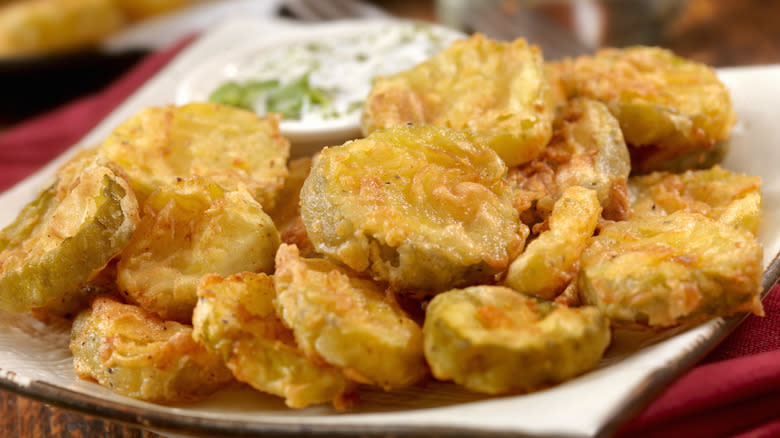For The Absolute Best Fried Pickles, Use Thicker Slices

Some people will fry anything -- or so the saying goes. Depending on where you live, that just might be true. But like it or not, fried pickles are the one enduring fried commodity that's entered the culinary mainstream. It appears on countless menus, from classic diners to fast-food venues but also in trendy metropolitan restaurants across the country. You could say that fried vegetables entered their heyday with the raging acclaim of "Fried Green Tomatoes," a film revolving around the antics and fried tomatoes of the Whistle Stop Cafe. But in reality, people have been making fried okra, cauliflower, and other veggies for generations.
It's just that pickles are easy to come by, and they happen to be superbly tasty when dipped in batter and sizzled in hot oil. But before plopping any-ole pickle in a frying pan, there's a few things to know. The first is that the width of each individual slice is very important. Anyone who's ordered fried pickles at a restaurant knows you're never served a whole fried pickle, nor one that's been sliced lengthwise. You instead get a plate of crispy, battered, fried pickles sliced crosswise across the mother pickle, resulting in cute little ragged circles.
The key to those crosscut-style circles is to slice them thick, with the absolute best fried pickles being about ¼-inch thick. Fortunately, when making your own fried pickles at home, you have control over that.
Read more: Vinegar Cooking Hacks You'll Wish You Knew Sooner
Getting The Ultimate Thickness For Fried Pickles

Buying pickles already sliced is convenient and easy, but you won't have much, if any, leeway for choosing the thickness of the slices. That puts you in the slicer's seat, holding a sharp-edged knife and the power to cut at will. Thinner cuts still work for fried pickles, but that ideal crosswise ¼-inch thickness elevates the pickles to a more substantial appetizer status.
Thicker slices hold up better for handheld bites like fried pickles, also known as fried pickle chips, thus avoiding a floppy, mushy, or messy texture you want to avoid. Even more important, that extra bit of thick pickle in each bite balances out the ratio of pickle interior to breading exterior, resulting in more pucker-perfect pickle flavor from your favorite dills. With thinner slices, you'll instead get more of a fried-batter taste. It may be tempting to pick up a jar of crinkle-cut pickles, also known as waffle-cuts, which do have some added texture from the corrugated surface. That helps some, but they're still a typically thin cut.
Another benefit of ¼-inch fried pickles is that the extra weight makes frying more consistent. The heavier slices are less likely to float around in the oil, risking pickle collisions that cause clumping. You want each fried pickle chip to stand proudly on its own merit when it reaches your appetizer platter. For even more convenient handling, try making your slices from a whole pickle with a relatively wide circumference.
Read the original article on Tasting Table.


